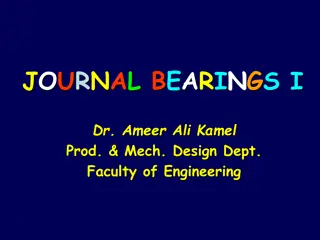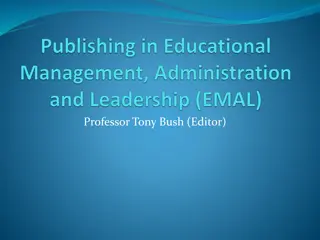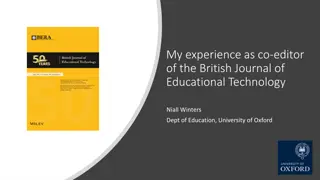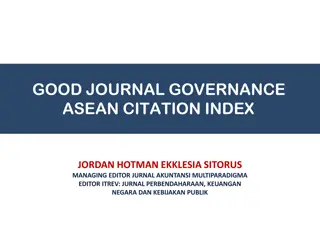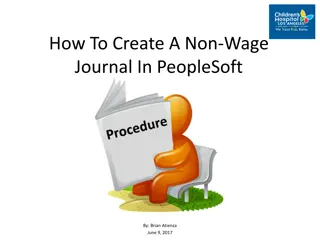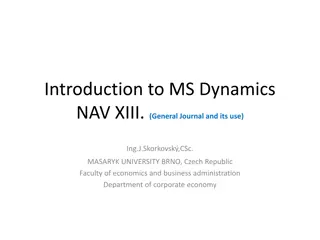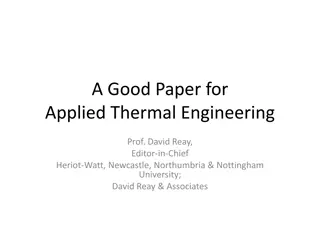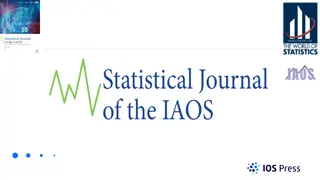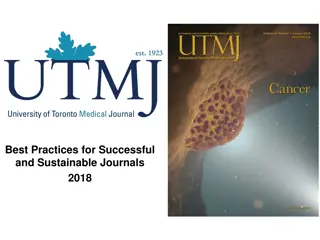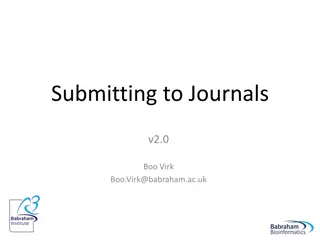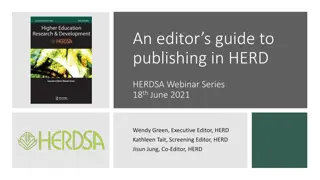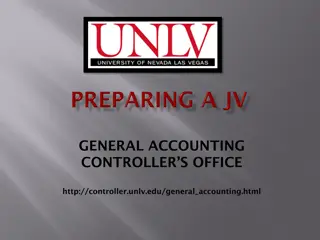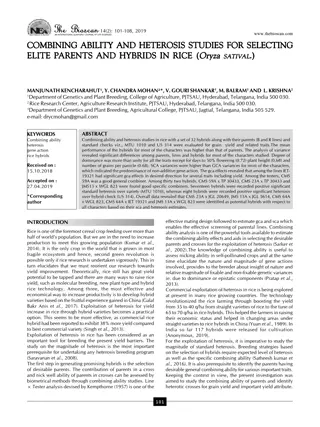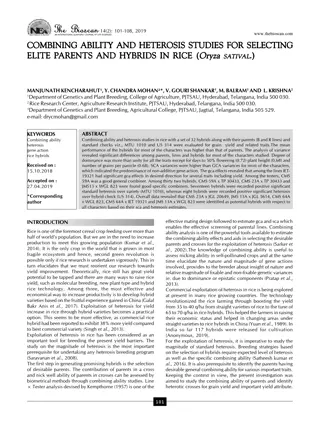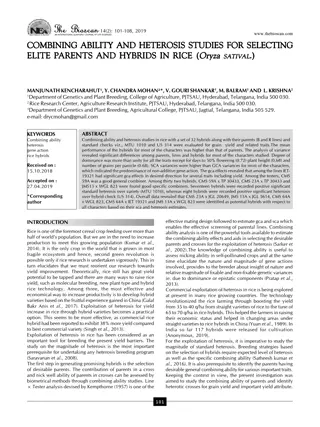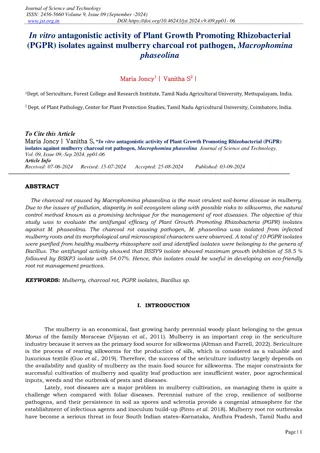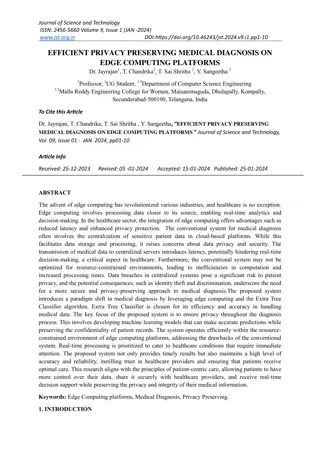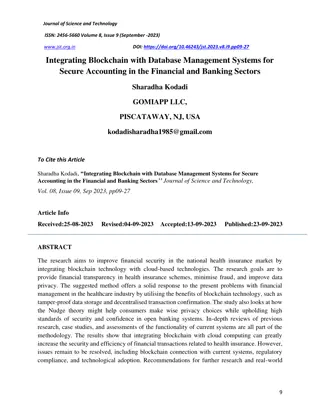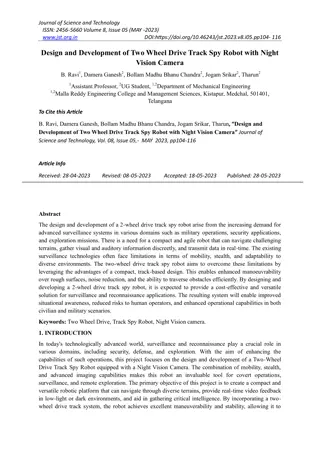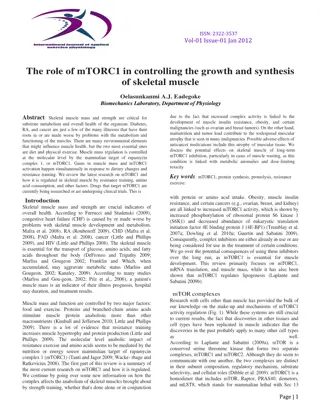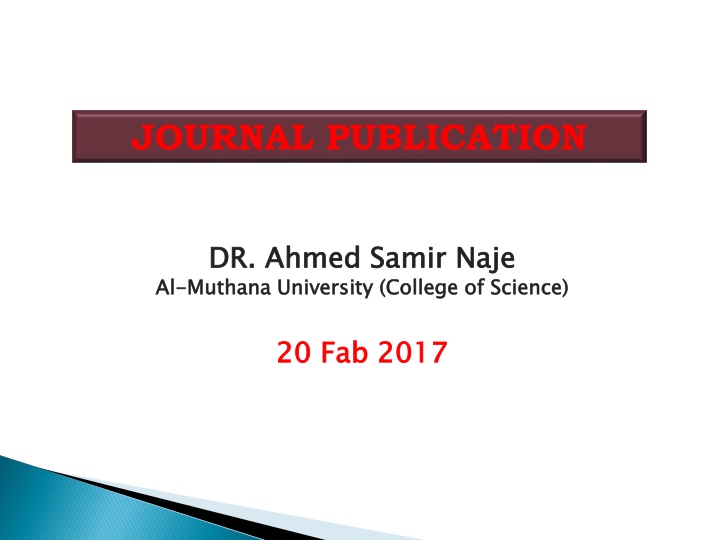
Factors for High Impact Journal Publication and Impact Evaluation Metrics
Explore the significance of publishing in high impact factor journals, understand journal impact factor, immediacy index, and cited half-life. Discover why it matters and when to use these metrics for scholarly contribution and visibility.
Download Presentation

Please find below an Image/Link to download the presentation.
The content on the website is provided AS IS for your information and personal use only. It may not be sold, licensed, or shared on other websites without obtaining consent from the author. If you encounter any issues during the download, it is possible that the publisher has removed the file from their server.
You are allowed to download the files provided on this website for personal or commercial use, subject to the condition that they are used lawfully. All files are the property of their respective owners.
The content on the website is provided AS IS for your information and personal use only. It may not be sold, licensed, or shared on other websites without obtaining consent from the author.
E N D
Presentation Transcript
JOURNAL PUBLICATION DR. Ahmed Samir Al- -Muthana DR. Ahmed Samir Naje Muthana University (College of Science) Naje Al University (College of Science) 20 Fab 2017 20 Fab 2017
Some factors to consider before article submission Journal Impact Factor Immediacy Index Cited Half Life 5 Year Journal Impact Factor Some factors to consider before article submission
Journal Impact factor Journal Impact factor The journal Impact Factor is the average number of times articles from the journal published in the past two years have been cited in the JCR year. Cites in 2008 to 2006 and 2007 papers Impact Factor (2008) = Papers published in 2006 and 2007 In simpler terms, it means An Impact Factor of 1.0 means that, on average, the articles published one or two year ago have been cited one time. An Impact Factor of 2.5 means that, on average, the articles published one or two year ago have been cited two and a half times.
Why publish in high Impact Factor journal? Higher citations rate means your article has higher chances of getting cited Higher reading rate means your article get read by more researchers More recognition in terms of scholarly contribution Why publish in high Impact Factor journal?
Journal Immediacy Index The Journal Immediacy Index quickly articles in a journal are cited The Immediacy Index is calculated by dividing the number of citations to articles published in a given year by the number of articles published in that year Journal Immediacy Index Journal Immediacy Index indicates how Immediacy Index = no. of citations (in current year) no. of articles (in current year) (in current year) In simpler terms, we can say An Immediacy Index of 1.0 means that, on average, the articles in the journal have been cited one time within the same year.
When to use Immediacy Index? When to use Immediacy Index? If you want your research to reach out to readers as quickly as possible For comparing journals specializing in cutting-edge research, the Immediacy Index can provide a useful perspective
Journal Cited Half Life Helps evaluate the average age range of articles cited from the journal Applications You use the Journal Cited Half Life to see if articles from a journal that were published a long time ago are still being cited. This shows you if the journal has a good track record and was producing good articles in the past Journal Cited Half Life
5 Year Journal Impact Factor 5 Year Journal Impact Factor The traditional Journal Impact Factor is based on two years of cited journal content cites in the current year to journal material published in the prior two years The 5-Year Impact Factor is based on cites in the current year to journal material published in the prior five years
5 Year Impact Factor is suitable for Journals where body of citations may not be large enough to make reasonable comparisons Publication schedules may be consistently late Journals that may take longer than two years to disseminate and respond to published works 5 Year Impact Factor is suitable for
How to log in to How to log in to Journal Citation Reports Journal Citation Reports? ? Step 1: To begin, log in to ISI Web of Knowledge, then select Additional Resources and click on Journal Citation Reports
How to find an Impact Factor, Immediacy Index, etc from Journal Citation Reports? Step 2: Go to JCR, you can select journal by: Subject Category Publisher or Country/Territory
Select your disciplines Step 3: Select your disciplines of journal. You can select more than one by pressing Ctrl key
Sort your metrics according to your needs Step 4: You can sort your metrics according to Impact Factor, Immediacy Index, etc.
Start analyzing the metrics and decide where to submit your article Step 5: Use the metrics to decide which journal is best for submission
If you want your article to Publish in most influential or highly cited journal Use Impact Factor or 5 Year Impact Factor (for subjects need longer citation period, e.g. GEOLOGY or MANAGEMENT or SOCIOLOGY, etc) To reach out to readers and be read immediately Use Immediacy Index Stay active in journal collection Use Cited Half Life Note: The above only serves as general guidelines, deeper understanding of JCR, the subjects and dynamic publication cycles are crucial when deciding where to publish your paper.
Notes to remember Impact Factor, Immediacy Index, etc, are meant to evaluate the world's leading journals Never compare Impact Factor or other metrics across different disciplines, such as Biophysics vs. Mathematics Biomedical Engineering vs. Civil Engineering Etc Why? Because different disciplines have different citation patterns!
General Knowledge Journal Publication utmpusing ISI IMPACT FACTOR OPEN ACESS SPECIAL ISSUE PUBLICATION SCIVAL-EXPERT.UTM SCOPUS INDEXED JOURNAL NON-INDEXED JOURNAL BOGUS JOURNAL CITATION H INDEX SELF CITATION CONFERENCE PROCEEDING CONFERENCE PROCEEDING BOOK CHAPTER JOURNAL PUBLICATION FEES JOURNAL WITH OWN IMPACT FACTOR ISI WEB OF KNOWLEDGE JOURNAL CITATION REPORT SCIENCE DIRECT H INDEX IN WEB OF SCIENCE H INDEX IN SCOPUS
Where to Publish? Indexed Journal Indexed Journal Non Non- -indexed indexed Journal Journal Conference Conference
Types of Journal Papers Full Short Communications Review Case studies Full Papers: contains Short Communications Review Articles Case studies Papers: contains original research original research Articles
utmpusing What is an Indexed Journal? A journal is Indexed when its bibliographic and citation information is included by the citation data supplier. For Research University the citation data supplier is Scopus & Web of Science - RMC
ISI Indexed Journals Scopus indexed Journals If published: better visibility, higher credibility, good incentive If rejected: valuable experience with free useful reviews. If your paper is of high quality but submitted to a non- ISI journal, you have wasted a rare chance
ISI Journals and Impact Factors The Institute for Scientific Information (ISI) was founded by Eugene Garfield in 1960. It was acquired by Thomson Scientific & Healthcare in 1992,became known as Thomson ISI. ISI publishes the annual Journal Citation Reports (JCR) which list the Impact Factor for the journals. A list of over 14,000 journals is maintained by the ISI.
What is an Impact Factor ? A journal s impact factor is an annual measure of the extent to which articles in that journal are cited. The 2011 impact factor of a journal would be calculated as follows: A = the number of times articles published in 2009 and 2010 were cited by indexed journals during 2011. B = the total number of "citable items" published by that journal in 2009 and 2010. 2011 impact factor = A/B.
H index What is H-index? The h-index is an index that attempts to measure both the productivity and impact of the published work of a scientist or scholar. The index is based on the set of the scientist s most cited papers and the number of citations that they have received in other publications. The index can also be applied to the productivity and impact of a group of scientists, such as a department or university or country. The index was suggested by Jorge E. Hirsch, a physicist at UCSD, as a tool for determining theoretical physicists relative quality and is sometimes called the Hirsch index or Hirsch number.
Criteria for choosing a journal Scope Indexing Impact Journal ranking Publication frequency Time to publish Scope of Indexing Impact factor Journal ranking Publication frequency Time to publish of journal journal factor
Criteria for choosing a journal Time to review Friendliness of the editor Rejection rate Reference Quality of review Members of editorial board Categories of journal
Read the Scope of the Journal Bioresource Technology (IF 4.750) The journal's aim is to advance and disseminate knowledge in all the related areas of biomass, biological waste treatment, bioenergy, biotransformations,and bioresource systems analysis, and technologies associated with conversion or production. Topics include: Biofuels: liquid and gaseous biofuels production, modeling and economics Bioprocesses and bioproducts: biocatalysis and fermentations Biomass and feedstocks utilization: bioconversion of agro-industrial residues Environmental protection: biological waste treatment Thermochemical conversion of biomass: combustion, pyrolysis, gasification, catalysis. The Journal does not consider articles dealing with crop cultivation, breeding and agronomy, plant extracts and enzymes, composites, marine organisms (except microorganisms and algae for bioprocesses), soil and air pollution, and performance of fuel combustion in engines.
Structure of Manuscript Structure of Manuscript (i) Titles (ii) Abstract (iii) Introduction (iv) Materials and Methods (v) Results and Discussion (vi) Conclusion (v) Acknowledgement (vi) Reference
What your paper is all about.It should be: Concise and relevant to the subject matter Attract attention (editors and readers) Interesting, significant and different from other papers Avoid abbreviations (depends on journal) Less than 15 words (depends on journal)
Who should be included as authors and who should be the corresponding author? Livestock wastewater treatment using aerobic granular sludge Inawati Othmana, Aznah Nor Anuar b, Noor Hasyimah Rosmana, Hasnida Haruna, Shreeshivadasan Chelliapanc aDepartment of Environmental Engineering, Faculty of Civil Engineering, Universiti Teknologi Malaysia, 81310 Skudai, Johor, Malaysia bInstitute of Environmental and Water Resource Management, WATER Research Alliance, Universiti Teknologi Malaysia, 81310 Skudai, Johor, Malaysia cUTM Razak School of Engineering and Advanced Technology, Universiti Teknologi Malaysia (UTM Kuala Lumpur), Jalan Semarak, 54100, Kuala Lumpur, Malaysia Received 19 November 2012, Received in revised form 21 January 2013, Accepted 29 January 2013, Available online 9 February 2013
The abstract should be short and precise Selling point of the paper. It is summary of the work (Introduction & Objective, Method, Results, Conclusion) No figure, table and reference. About 200 words should be sufficient
Abstract: Problem statement:Tylosin has been considered inhibiting COD removal in anaerobic digestion. In this study it is proven that this is not always the case. Accordingly, elevated concentrations of Tylosin (100 800mgL1) could be tolerated by the anaerobic system. Approach: The influence of Tylosin concentrations on an up-flow anaerobic stage reactor (UASR) was assessed using additions of Tylosin phosphate concentrate. Results:Results showed high efficiency for COD removal (average 93%) when Tylosin was present at concentrations ranging from 0 to 400mgL1. However, at Tylosin concentrations of 600 and 800mgL1 treatment efficiency declined to 85% and 75% removal respectively. The impact of Tylosin concentrations on archaeal activity were investigated and the analysis revealed that archaeal cells dominated the reactor, confirming that there was no detectable inhibition of the methanogens at Tylosin levels between 100 and 400mgL1. Nevertheless, the investigation showed a slight reduction in the number of methanogens at Tylosin levels of 600 and 800mgL1. Conclusion/ Recommendations:These results demonstrated that the methanogens were well, adapted to Tylosin. It would not be expected that the process performance of the UASR would be affected, not even at a level well in excess of those appearing in real wastewater from a Tylosin production site.
The keywords should reflect the subject matter of the manuscript in the same way the title of the manuscript should. Most of the keywords may already be present in the title The number of keywords should not be more than five Use only established abbreviations (i.e. DNA)
Serves as an orientation for readers, giving them the perspective detailed information coming in later sections. perspective they need to understand the Contain review of up-to-date literature. Explain the novelty of the work. Discuss the objective and significance of the work.
Introduction First Stage: Second Stage aspects of the problem Third Stage: investigation. Fourth Stage: objectives Fifth Stage: justification. First Stage: general statements about field of research Second Stage: More specific statements about the Third Stage: Statements that indicate the need for more Fourth Stage: Very specific statements giving the Fifth Stage: Optional statements that give values or
Examples of 3rd Stage Introduction However, few studies have reported on the effects of computer assisted instruction But there is little information available on the air flow rates on simple flat plate solar collectors
Example of 3rd Stage Introduction Flammability of Wood-Polypropylene Composites. On the basis of the above mentioned facts, it may be concluded that it is worth studying the influence of rheological properties of polymeric matrix on the supermolecular structure and mechanical properties obtained in polypropylene/wood composites. Until now, investigations of the influence of polypropylene matrix MFI on the flammability characteristic of the composites with been carried out. Until now, investigations of the influence of polypropylene matrix MFI on the flammability characteristic of the composites with lignocellulosic been carried out. lignocellulosic materials have not materials have not Polymer Degradation and Stability
Example of 4th Stage Introduction Even though a lot of work has been reported on the flammability of polymers, very little work has been reported on the flammability of the composites. The objective of this paper is to study the effects of Mg(OH)2 on the flammability and mechanical properties of wood/natural composites. The objective of this paper is to study the effects of Mg(OH)2 on the flammability and mechanical properties of wood/natural fibre composites. fibre
Very recently, a comprehensive and general review article dealing with study on various aspects of cellulosic biofibers and biocomposite materials was published [19]. The overview on biocomposite science and technology, its environmental issues and market potential were found in the literature [8]. In year 2000 and 2004, a review article [20] about structural discussion on certain biofibers, biodegradable polymers, and biocomposites, and an overview article [21] on pineapple leaf and sisal fiber and their biocomposite reinforced with thermoset and thermoplastic polymers was published, respectively. Nevertheless, a specific review article on OPEFB fiber polymer composite materials including both thermoplastic and thermosets polymers have not been published so far to our knowledge. Indeed, it becomes essential to assess the previous and ongoing research for OPEFB fiber polymercomposite materials. This will surely enable the researchers, materialist, industrialists, scientist, and upcoming experts to establish the lag in till date research work and find approach for futuristic development for OPEFB fiber polymer composite materials. This might even open room for development of other natural fiber polymeric composite materials. Shows our understanding ability Shows our understanding of the literature ability to of the literature and our work. and our to or or analyze people s analyze people s work
The description should be detail enough for others to repeat the experiment. The equipment and materials must be adequately described The measurements must clearly described.
Results and Discussions section is the most important part of the manuscript in which critical analysis of the results are done. Sufficient number of Figures and Tables with good quality. Compare with previous studies Consistent with Materials and Methods.
Conclusions A review of the most important findings of the work This section should re-inforce the originality of the work presented. Should be consistent with the objectives highlight the achievements.
Must fulfill the study objectives Include how the paper advances research in this area. Refers to only work done in the present study Should not be more than one third of a page Include practical implications of the study Recommendations for future works
Give credit to funding authorities, collaborators or other colleagues whose names do not appear as co-authors but had made some contribution in producing the material for the manuscript
Author, Author, year year style style (Harvard) (Harvard) Adrian, R.J., Particle-imaging techniques for experimental fluid mechanics. Ann. Rev. Fluid Mech., 1991. 23: p. 261-304. Alapati, A., Kang, S., Suh, Y.K., 3D lattice Boltzmann simulation of droplet formation in a cross-junction microchannel, in Proc. 3rd IASME/WSEAS Intl. Conf. Cont. Mech. 2008. Breyiannis, G.V., Lattice kinetic simulations in three-dimensional magneto hydrodynamics. Phys. Rev. , 2004. E 69: p. 065702/1-065702/4. Cercignani, The Boltzmann equation and its application in applied mathematical sciences. Springer, 1988.
Numbering Numbering style style [1]Couette, M., 1890. Etudes sur le frottement des liquides. Ann. Chim. Phys., 21: 433. [2]Taylor, G.I., 1923. Stability of a viscous fluid contained between two rotating cylinders. Philos. Trans. R. Soc. London, Ser. A, 233: 289. [3]Di Prima, R. C., Swinney, H. L. 1981. Instabilities and transition in flow between concentric rotating cylinders, in: Hydrodynamic instabilities and transition to turbulence (Swinney, It. L., Gollub, J. P., eds.), p. 139. Springer [4]B hler, K., Wimmer, Zierep, M. J., and Coney J. E. R., 1986 Advances in Taylor Vortex Flow: A report on the Fourth Taylor Vortex Flow Working Party meeting Acta Mechanica, Vol 62(1) pp 47-61
Traditional submission (by mail) As e-mail attachment Via a journal online submission Include a cover letter
Title and author(s) of paper Type of submission (full length article/ technical note) Fact that paper is new and not being submitted elsewhere Why the paper is important Some possible peer reviewers (some journal request that)

